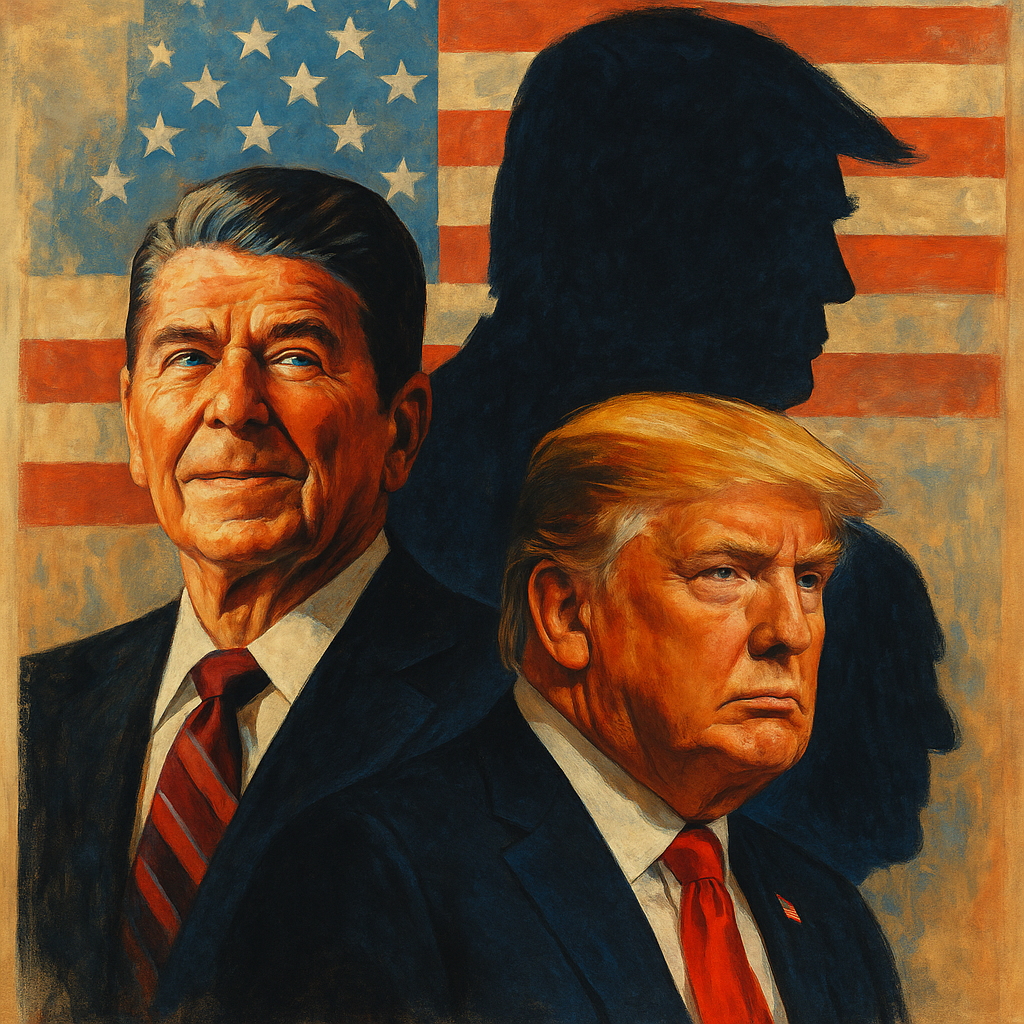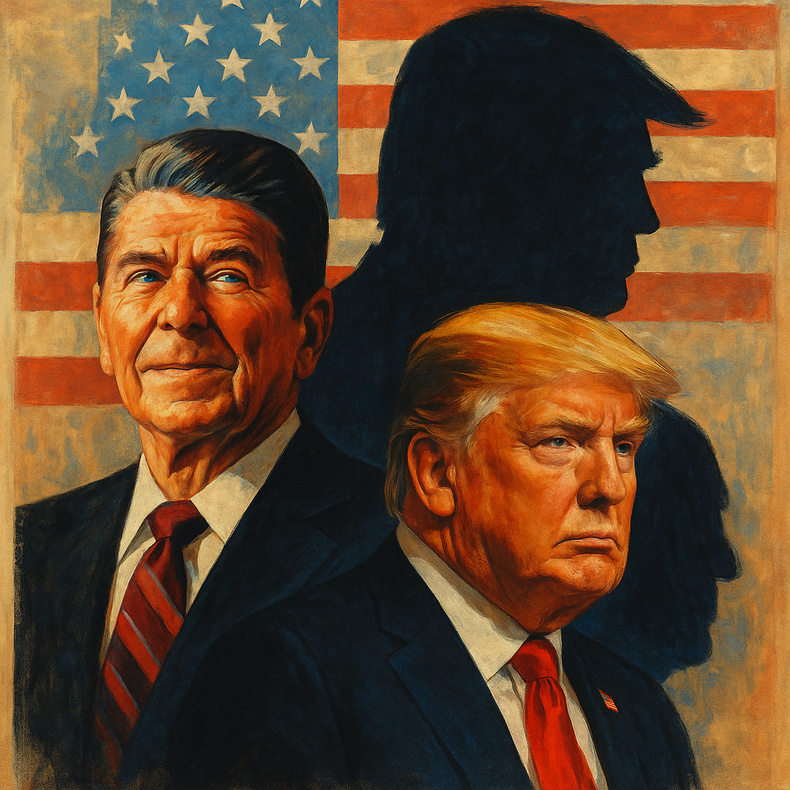A smiling portrait of Ronald Reagan, framed in gold, hangs behind the Resolute Desk — a silent observer of Donald Trump’s presidency. For Trump, the image is both inspiration and burden. While Reagan remains the benchmark of conservative leadership, Trump’s vision for America has often clashed with the principles that Reagan embodied. The two men, divided by decades, are now locked in an unspoken rivalry for the soul of the Republican Party.
Reagan as the Conservative Blueprint
Ronald Reagan’s presidency from 1981 to 1989 reshaped modern conservatism. His philosophy of limited government, low taxes, and strong defense helped rebuild Republican confidence after the turbulent 1970s. Reagan’s charm and optimism — famously captured in his “Morning in America” message — cemented his legacy as the “Great Communicator.” For millions of conservatives, he became the model of what a Republican president should be: confident, principled, and global in outlook.
Reagan’s success lay not just in policy but in tone. He balanced firm conservative ideals with pragmatic governance, often working with Democrats to achieve compromise. His leadership combined ideology with diplomacy, making conservatism appear not as confrontation but as reassurance. That balance has defined Republican nostalgia for decades and explains why Reagan’s name still dominates party conventions and campaign speeches.
Trump’s presidency, by contrast, emerged from a very different political environment — one of populist discontent, economic anxiety, and distrust in institutions. Yet to consolidate power, Trump needed to inherit the conservative mantle that Reagan left behind. Installing Reagan’s portrait in the Oval Office served as a visual pledge of continuity — but it also exposed a deeper contrast between two political worlds.
The Ideological Divide Between Reaganism and Trumpism
Where Reagan built bridges, Trump often burns them. Reagan’s America was outward-looking, confident in free trade and international cooperation. He promoted globalization as a vehicle for U.S. strength and sought closer ties with allies like Japan, Britain, and NATO partners. Trump’s America is more protectionist and skeptical of global engagement, viewing trade agreements and alliances as deals that disadvantage the U.S.
This ideological divide runs deep. Reagan’s belief in free trade contrasted sharply with Trump’s tariff wars. Reagan called tariffs a “hidden tax on consumers,” using them only sparingly as strategic tools. Trump, however, made tariffs central to his economic policy — a direct challenge to Reagan’s approach. When Canadian officials aired an anti-tariff ad quoting Reagan’s warnings about trade wars, Trump abruptly suspended trade talks in response, revealing just how personally he reacts to Reagan’s shadow.
Their worldviews also diverge on diplomacy. Reagan believed in U.S. leadership through alliances; Trump favored transactional relationships. Reagan sought to project American power through persuasion, Trump through pressure. Where Reagan cultivated calm authority, Trump thrived on disruption. The contrasts underscore how far the Republican Party’s center of gravity has shifted since the 1980s.
The Political Utility of Reagan’s Image
Despite the differences, Trump has long recognized the power of Reagan’s symbolism. For millions of conservatives, invoking Reagan still means invoking the golden age of Republican unity and confidence. Trump uses that nostalgia to fortify his claim as heir to the movement — an inheritor who embodies its toughness, even if not its temperament.
The portrait in the Oval Office is more than décor. It signals to party loyalists that Trump stands in a tradition of greatness. His campaign slogans — “Make America Great Again” and “America First” — echo Reagan’s optimistic nationalism, but with sharper edges. Where Reagan promised renewal through cooperation, Trump promises restoration through confrontation. The rhetoric is similar, but the philosophy is inverted.
For Trump’s supporters, the Reagan connection offers comfort. For his critics within the GOP, it reveals contradiction. They see a president who claims Reagan’s legacy but rejects his principles — particularly on civility, diplomacy, and moral leadership. Yet even those critics hesitate to abandon Reagan’s image entirely, aware that his name still unites the conservative base more effectively than any living Republican figure.
Reagan’s Legacy as Trump’s Unseen Rival
Reagan’s posthumous influence extends beyond nostalgia; it represents a moral and ideological yardstick that Trump cannot escape. Within the Republican Party, every debate — over trade, immigration, or America’s role abroad — still references Reagan’s legacy. For decades, to be a “Reagan Republican” was the ultimate compliment. Today, that phrase is both a badge and a battleground.
Trump’s dominance within the party has muted open dissent, but Reagan’s ghost continues to haunt policy debates. Older conservatives see Trump’s approach as a betrayal of Reagan’s optimism. Younger populists see Reagan’s moderation as weakness. The clash defines today’s GOP identity crisis — a struggle between globalist conservatism and nationalist populism.
When Trump lashed out at the Canadian ad quoting Reagan, the reaction revealed insecurity as much as anger. To Trump, Reagan is not merely a predecessor but a competitor — one whose reputation still commands the reverence Trump seeks. Political analysts note that Trump’s occasional attempts to mirror Reagan’s charm or bipartisanship often feel forced, precisely because his political style thrives on division rather than reconciliation.
Reagan remains a safe reference point for Republicans seeking unity. His image allows the party to look backward for stability even as it lurches forward into turbulence. Trump’s challenge is that he wants to own Reagan’s mythology while rewriting its meaning. It’s a delicate act — embracing the saint while dismantling the church.
How the Reagan Legacy Still Shapes Trump’s America
Reagan’s influence over the modern Republican psyche ensures that Trump’s presidency exists in constant comparison. Reagan represented order; Trump, disruption. Reagan believed in persuasion; Trump, dominance. Yet both men shared the instinct to reshape politics around their personal brands — to make conservatism inseparable from identity. That common thread links them more deeply than ideology ever could.
The continued reverence for Reagan serves Trump’s political needs even as it reminds voters of what he is not. By standing beneath Reagan’s portrait, Trump borrows credibility. But the same image also magnifies his differences — in tone, policy, and principle. Every Oval Office decision that departs from Reagan’s philosophy reinforces the sense that Trump is leading the GOP into uncharted territory.
Still, the shadow endures. Reagan’s ghost hovers over Republican politics because his presidency defined not only a generation but a myth — the idea that conservative leadership could unite, inspire, and reassure. Trump’s presidency, by contrast, thrives on polarization and defiance. The two legacies now coexist uneasily: one rooted in optimism, the other in outrage.
Reagan’s America believed in a shining city on a hill; Trump’s America vows to rebuild that city from within its walls. The portrait in the Oval Office captures that paradox — two Republican presidents bound by power, separated by principle, and forever linked in history.
(Source:www.reuters.com)
Reagan as the Conservative Blueprint
Ronald Reagan’s presidency from 1981 to 1989 reshaped modern conservatism. His philosophy of limited government, low taxes, and strong defense helped rebuild Republican confidence after the turbulent 1970s. Reagan’s charm and optimism — famously captured in his “Morning in America” message — cemented his legacy as the “Great Communicator.” For millions of conservatives, he became the model of what a Republican president should be: confident, principled, and global in outlook.
Reagan’s success lay not just in policy but in tone. He balanced firm conservative ideals with pragmatic governance, often working with Democrats to achieve compromise. His leadership combined ideology with diplomacy, making conservatism appear not as confrontation but as reassurance. That balance has defined Republican nostalgia for decades and explains why Reagan’s name still dominates party conventions and campaign speeches.
Trump’s presidency, by contrast, emerged from a very different political environment — one of populist discontent, economic anxiety, and distrust in institutions. Yet to consolidate power, Trump needed to inherit the conservative mantle that Reagan left behind. Installing Reagan’s portrait in the Oval Office served as a visual pledge of continuity — but it also exposed a deeper contrast between two political worlds.
The Ideological Divide Between Reaganism and Trumpism
Where Reagan built bridges, Trump often burns them. Reagan’s America was outward-looking, confident in free trade and international cooperation. He promoted globalization as a vehicle for U.S. strength and sought closer ties with allies like Japan, Britain, and NATO partners. Trump’s America is more protectionist and skeptical of global engagement, viewing trade agreements and alliances as deals that disadvantage the U.S.
This ideological divide runs deep. Reagan’s belief in free trade contrasted sharply with Trump’s tariff wars. Reagan called tariffs a “hidden tax on consumers,” using them only sparingly as strategic tools. Trump, however, made tariffs central to his economic policy — a direct challenge to Reagan’s approach. When Canadian officials aired an anti-tariff ad quoting Reagan’s warnings about trade wars, Trump abruptly suspended trade talks in response, revealing just how personally he reacts to Reagan’s shadow.
Their worldviews also diverge on diplomacy. Reagan believed in U.S. leadership through alliances; Trump favored transactional relationships. Reagan sought to project American power through persuasion, Trump through pressure. Where Reagan cultivated calm authority, Trump thrived on disruption. The contrasts underscore how far the Republican Party’s center of gravity has shifted since the 1980s.
The Political Utility of Reagan’s Image
Despite the differences, Trump has long recognized the power of Reagan’s symbolism. For millions of conservatives, invoking Reagan still means invoking the golden age of Republican unity and confidence. Trump uses that nostalgia to fortify his claim as heir to the movement — an inheritor who embodies its toughness, even if not its temperament.
The portrait in the Oval Office is more than décor. It signals to party loyalists that Trump stands in a tradition of greatness. His campaign slogans — “Make America Great Again” and “America First” — echo Reagan’s optimistic nationalism, but with sharper edges. Where Reagan promised renewal through cooperation, Trump promises restoration through confrontation. The rhetoric is similar, but the philosophy is inverted.
For Trump’s supporters, the Reagan connection offers comfort. For his critics within the GOP, it reveals contradiction. They see a president who claims Reagan’s legacy but rejects his principles — particularly on civility, diplomacy, and moral leadership. Yet even those critics hesitate to abandon Reagan’s image entirely, aware that his name still unites the conservative base more effectively than any living Republican figure.
Reagan’s Legacy as Trump’s Unseen Rival
Reagan’s posthumous influence extends beyond nostalgia; it represents a moral and ideological yardstick that Trump cannot escape. Within the Republican Party, every debate — over trade, immigration, or America’s role abroad — still references Reagan’s legacy. For decades, to be a “Reagan Republican” was the ultimate compliment. Today, that phrase is both a badge and a battleground.
Trump’s dominance within the party has muted open dissent, but Reagan’s ghost continues to haunt policy debates. Older conservatives see Trump’s approach as a betrayal of Reagan’s optimism. Younger populists see Reagan’s moderation as weakness. The clash defines today’s GOP identity crisis — a struggle between globalist conservatism and nationalist populism.
When Trump lashed out at the Canadian ad quoting Reagan, the reaction revealed insecurity as much as anger. To Trump, Reagan is not merely a predecessor but a competitor — one whose reputation still commands the reverence Trump seeks. Political analysts note that Trump’s occasional attempts to mirror Reagan’s charm or bipartisanship often feel forced, precisely because his political style thrives on division rather than reconciliation.
Reagan remains a safe reference point for Republicans seeking unity. His image allows the party to look backward for stability even as it lurches forward into turbulence. Trump’s challenge is that he wants to own Reagan’s mythology while rewriting its meaning. It’s a delicate act — embracing the saint while dismantling the church.
How the Reagan Legacy Still Shapes Trump’s America
Reagan’s influence over the modern Republican psyche ensures that Trump’s presidency exists in constant comparison. Reagan represented order; Trump, disruption. Reagan believed in persuasion; Trump, dominance. Yet both men shared the instinct to reshape politics around their personal brands — to make conservatism inseparable from identity. That common thread links them more deeply than ideology ever could.
The continued reverence for Reagan serves Trump’s political needs even as it reminds voters of what he is not. By standing beneath Reagan’s portrait, Trump borrows credibility. But the same image also magnifies his differences — in tone, policy, and principle. Every Oval Office decision that departs from Reagan’s philosophy reinforces the sense that Trump is leading the GOP into uncharted territory.
Still, the shadow endures. Reagan’s ghost hovers over Republican politics because his presidency defined not only a generation but a myth — the idea that conservative leadership could unite, inspire, and reassure. Trump’s presidency, by contrast, thrives on polarization and defiance. The two legacies now coexist uneasily: one rooted in optimism, the other in outrage.
Reagan’s America believed in a shining city on a hill; Trump’s America vows to rebuild that city from within its walls. The portrait in the Oval Office captures that paradox — two Republican presidents bound by power, separated by principle, and forever linked in history.
(Source:www.reuters.com)















